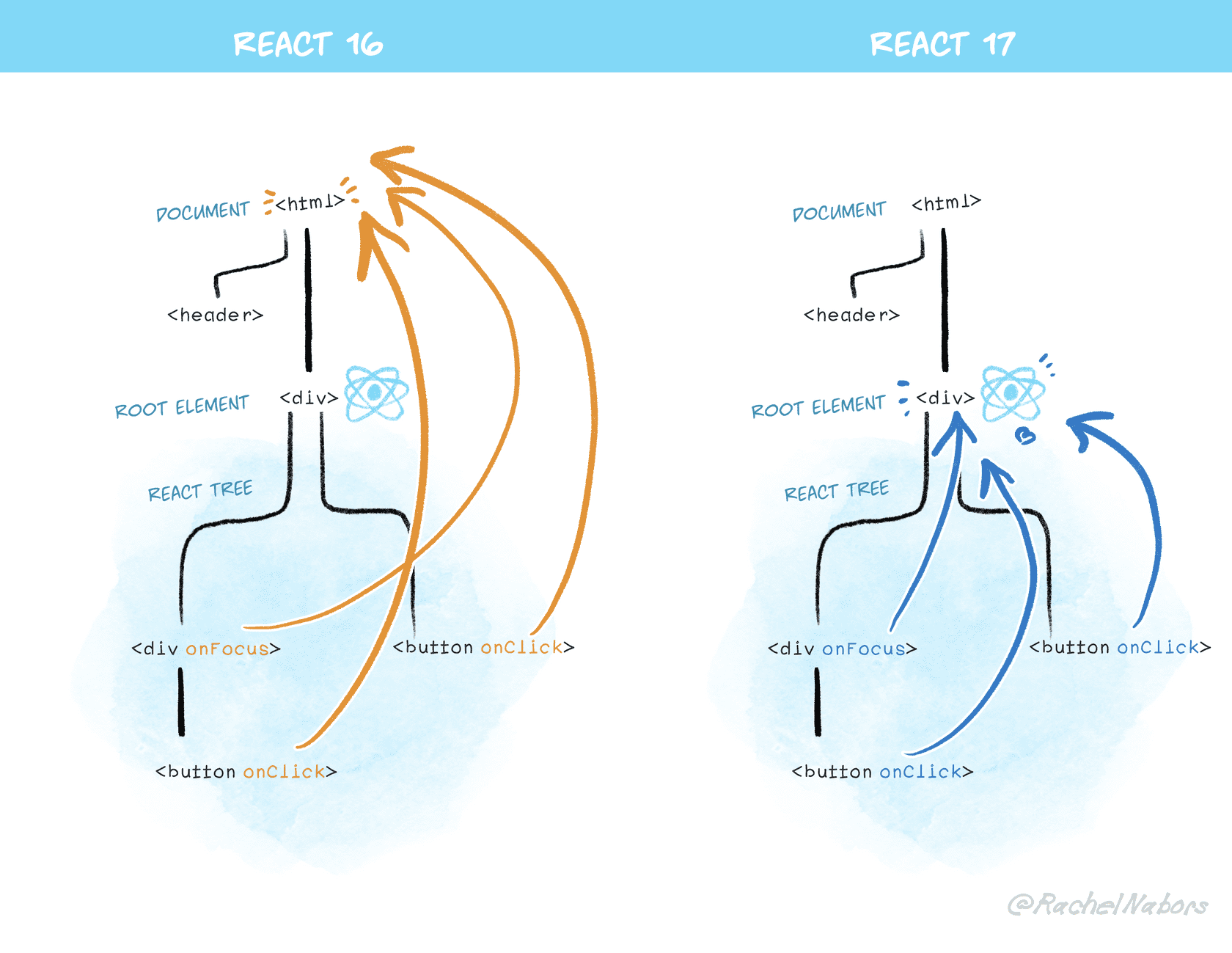React 렌더링
하드 코딩된 HTML 마크업
1 | <!-- Actual DOM Node : Container --> |
DOM API - Actual DOM Tree 로 변경
1 | <!-- Programming DOM Script : Actual DOM Tree--> |
- console.dir(appNode); → 실제 DOM 노드
React API - Virtual DOM Tree 로 변경
CDN : React Library → React.createElement(), React.forwardRef() 등…
React 앱을 구성하는 가상 DOM을 생성하는 API
1 | <script src="//unpkg.com/react/umd/react.development.js" crossorigin></script> |
React.create.Element()
1 | React.createElement( |
1 | const appElement = React.createElement( |
인자로 주어지는 타입에 따라 새로운 React Element를 생성하여 반환한다.
- type 인자로는 HTML Standards Component를 문자열로 입력한다. 혹은 React 컴포넌트 타입이나 React Fragment 타입 중 하나가 올 수도 있다.
- props는 반드시 object(객체) 타입이어야 한다.
- children은 null 또는 undefined 또는 React.ReactNode 타입이다.
1 | // React element 생성 |
console.log(appElement) → **가상 DOM 노드 = 그냥 “객체”**이다.
{$$typeof: Symbol(react.element), type: “div”, key: null, ref: null, props: {…}, …}
$$typeof: Symbol(react.element)
props: {className: “app”, lang: “en”, children: Array(2)}
children: Array(2)
0: {$$typeof: Symbol(react.element), type: “h1”, key: null, ref: null, props: {…}, …}
1: {$$typeof: Symbol(react.element), type: “ul”, key: null, ref: null, props: {…}, …}
length: 2
className: “app”
lang: “en”
type: “div”
실제 DOM 노드는 아주 많은 속성들이 있었는데 react의 가상 DOM 노드는 심플한 객체이다.
= 불필요한 건 빼고 필요한 것들로만 객체를 만들었다. = 추상화를 했다.
= 그래서 더 빠르나 실제 DOM이 아니기 때문에 변환과정(= render()함수를 사용)이 필요하다.
실제 DOM 으로 변환
= 생성한 가상 DOM 노드를 렌더링하기 위해 아래의 API를 추가하여 render()함수를 사용한다.
CDN: ReactDOM Library → ReactDOM.render()
React에 의해 구성된 앱(가상 DOM)을 실제 DOM에 렌더링 되도록하는 API
(비교 | CDN: React Library - React 앱을 구성하는 가상 DOM을 생성하는 API)
1 | <script src="//unpkg.com/react-dom/umd/react-dom.development.js" crossorigin></script> |
ReactDOM.render()
가상 DOM Tree(React 루트 요소)를 실제 DOM에 마운트(Mount)하여 렌더링(Rendering)한다.
1 | ReactDOM.render(element, container[, callback]) |
1 | // vNode → 가상 DOM Tree (React 요소로 구성) |
1 | render(appElement, rootNode); |
우클릭 > 페이지 소스 보기
페이지 소스 보기에서는 < div id=”root” >< / > 안에 아무것도 없다.
= 즉, 검색봇이 크롤링을 할 때 좋지 않다.
= 검색 엔진 최적화X
Babel Standlone.
ES6+ 문법의 경우, ES6+ 문법을 지원하지 않는 브라우저에서는 깨질 수 있다.
그래서 node.js에서 Babel을 사용해서 버전을 내려주었다.
Babel Standalone 을 사용하면, 웹 브라우저 환경에서 버전을 내려줄 수 있다.
Babel 컴파일러가 실시간 컴파일 하도록 Bable의 독립형 빌드를 제공하기 때문.
1 | <script src="https://unpkg.com/babel-standalone/babel.min.js" crossorigin></script> |
위 코드를 불러오기만 한다고 컴파일되지는 않는다.
아래와 같이 < script >태그에 bind type을 지정해서 컴파일할 코드를 지정해줘야한다.
왜? 효율적으로 관리하기 위해서 바꿔주고자 하는 코드가 어떤 건지 식별할 수 있어야하기 때문.
bind type으로 text/babel 또는 text/jsx 타입이 적용하면,
브라우저에 로드될 때, Bablel Standalone이 해당 스크립트 태그들 모두를 컴파일 하고 실행한다.
(표준에서 bind type은 text/ecmascript 나 text/javasctipt )
1 | <script type="text/babel"></> |
브라우저에서 결과를 확인하면 < head > 영역에 없던 < script > 태그가 생겨있다.
그 < script >태그 안에서 Babel이 컴파일한 결과 코드를 볼 수 있다.
ES6+의 문법이 그 아래 버전으로 변환되어 있는 것을 확인할 수 있다.
변환은 브라우저가 렌더링될 때 실시간으로 컴파일된다.
! 브라우저에서 Babel을 사용하면 아래와 같은 경고가 출력된다.
서비스를 생산할 때 Babel을 이용할 경우, 일반적으로 Babel Standalone은 권장되지 않기 때문.
왜? 느리기 때문.
대신 Webpack 같은 Node.js에서 실행되는 빌드 시스템을 사용해 JavaScript를 사전에 미리 컴파일 해야한다.
그럼 언제 사용해야하나? (바벨 공식문서 - When (not) to use @babel/standalone 에 나와있다.)
브라우저에서 Babel 사용 시 경고( = babel standalone 사용 시)
CDN: ReactDOMServer Library → ReactDOMServer.renderToString(), renderToStaticMarkup() 등…
실제 DOM에 렌더링 하는 대신, 서버에서 React 앱을 렌더링 하기 위한 API
(클라이언트에서는 쓸 일이 없고 express 서버 등 서버쪽에서 렌더링을 할 때 필요하다. )
1 | <script src="//unpkg.com/react-dom/umd/react-dom-server.browser.development.js" crossorigin></> |
ReactDOMServer.renderToStaticMarkup()
서버에서 렌더링할 때 사용하므로, 서버에서 렌더링 된 결과를 클라이언트로 보내기 위해
React 객체를 HTML String 값으로 변환한다.
= 문자로 만드는 것이 목표
?????renderToString()과 비슷하지만 내부적으로 React의 고유한 key 등을 포함하고 있어 순수한 HTML String값으로 반환된다.?????
1 | // ReactDOMServer API |
appElement를 renderToStaticMarkup() 메서드를 이용해 텍스트로 변환하면 아래와 같은 HTML String 값이 반환된다.
= 가상 노드가 실제 노드로 변경된 후 텍스트로 변환된 것
= HTML String 값
1 | <div class="app" lang="en"> |
JSX
JSX는 ECMAScript에서 사용할 수 있는 XML과 유사한 구문 확장
ECMAScript 표준에 통합하지는 제안은 아니다.
= 그런 측면에서 React에서 사용한다.
= ES6+에서 기본 표현식(Primary Expression)을 확장한 자바스크립트의 식이다.
= ES6+ 미만에서는 babel이 필요(지금은 babel standalone 사용하니 괜찮다.)
= < Dropdown >, < Menu >, < MenuItem > 등 개발자가 만든 컴포넌트를 이용한다.
xml 유형의 문법이라서 self closing을 꼭 해야한다. 안 하면 오류이다. 그런데 React가 알려준다.
엔진이나 브라우저에서 구현하기 위한 것이 아니다.
(JSX, Jest, React 다 facebook에서 만들었다.)
JSX is an XML-like syntax extension to ECMAScript without any defined semantics. It’s NOT intended to be implemented by engines or browsers. It’s NOT a proposal to incorporate JSX into the ECMAScript spec itself. It’s intended to be used by various preprocessors (transpilers) to transform these tokens into standard ECMAScript.
JSX | XML-like syntax extension to ECMAScript
1 | // Using JSX to express UI components. |
JSX 로 변경
1 | render( |
< div ~ >~< / > 는 자바스크립트의 식이지 HTML template이 아니다.
= class가 아니라 className을 써야한다.headingElement와 listElement가 {} 보간에 의해 app JSX에 끼워넣어진 것이다.
{} 는 React에서 JSX를 사용할 때, 다른 컨텐츠를 끼워넣기 위해 사용하는 보간(Interpolation)
여기서 {} 안은 JS로 동작한다.
(마치 JavaScript에서 ``(백틱)을 사용할 때, 다른 컨텐츠를 끼워넣기 위한 보간인 ${}과 같다.)
<></>와 같이 fragment로 감싸줄 수 있는 데 이는 뒤에서 자세히 설명한다.
JSX에서 {false}, {null}, {undefined} 등 0을 제외한 falsy한 값은 렌더링 시 아무 것도 나타나지 않는다.
JSX에서 &&(엔드 연산자)와 삼항 연산자를 이용해 조건부 렌더링이 가능하다.
- { isTrue && < div >< /> }
- < div >{ isTrue ? ‘true다’ : ‘false다.’ }< />
babel이 JSX인 위 코드를 아래와 같이 React API로 변경해준다.
1 | render( |
JSX : React VDOM Tree -> render -> Actual DOM Mount
1 | function App(props /* { frameworkName, style } */) { |
